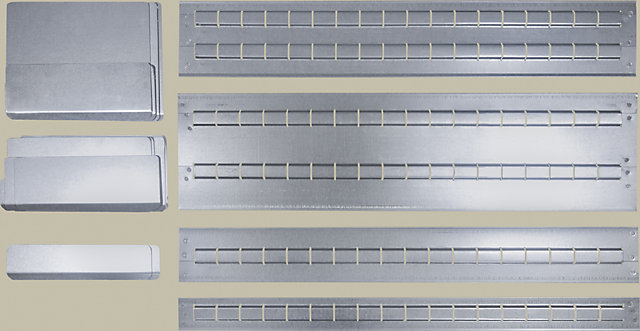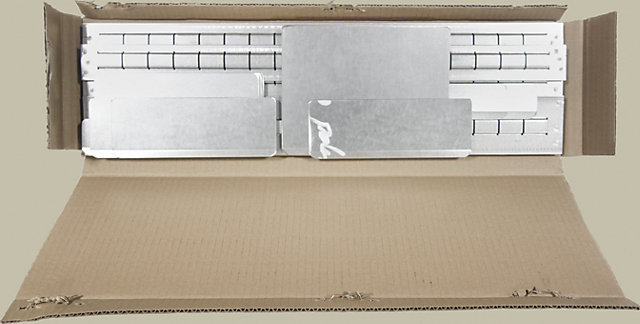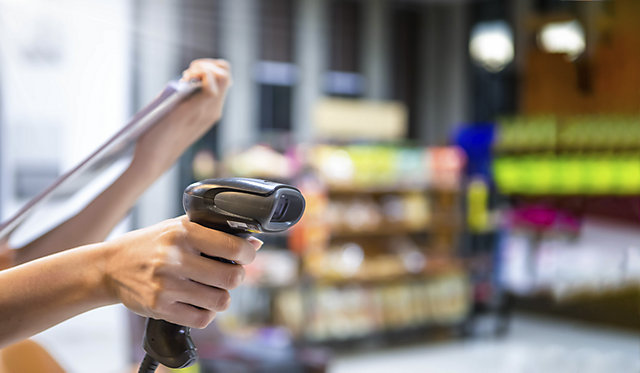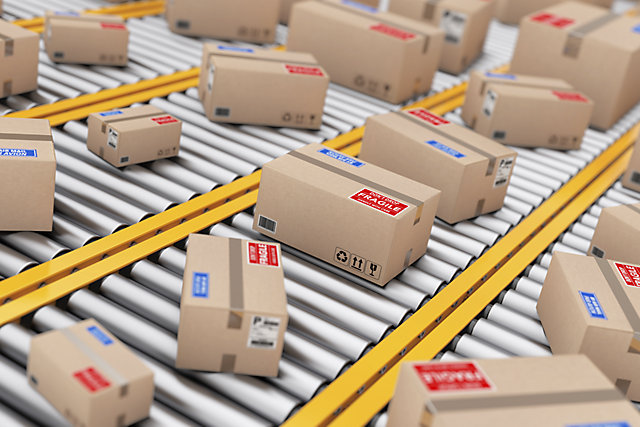
Goods flow explained simply
Material flow – are you joining us on a product journey?
What do you understand by material flow? If you are familiar with enterprise resource planning, you know that “material flow is the description of the transportation of raw materials, pre-fabricates, parts, components, integrated objects and final products as a flow of entities.” By the way, this choice of words is from the Wikipedia entry for “Material flow” and sounds very abstract to most people. It is, because the management of the material flow in your company is extremely complex and extensive.
To help you better understand the simple processes behind it, we’ll take you on the journey of our drawer divider set, limiting ourselves to the flow of only one product and thus saying goodbye to all complexity.
It always starts at the manufacturer’s warehouse
The EUROKRAFTpro drawer divider set consists of one longitudinal divider and four cross dividers per set and is delivered in such a way that these parts only have to be joined together. That’s what the data sheet says. And this is the only way it will be accepted by recipients later on.
This means that the individual parts are first assembled during production, before anything is stored or shipped at all. And this is where the material flow already begins.

Transport route 1: Manufacturer’s warehouse –> Manufacturer’s production facility

In manufacturing companies, most areas must be regularly equipped with raw materials, consumables, supplier parts and semi-finished products as well as office supplies and spare parts in general. Conveyor systems have therefore been installed in many production facilities. Goods can be fed quickly and effectively by roller conveyors or conveyor belts. This is particularly suitable for very large production halls. In smaller production facilities, employees pick up some of the goods themselves from the storage location. However, large parts must also be moved here with the aid of transport equipment.
In the case of our drawer divider set, one employee also joins the four divider plates of the cross dividers with the divider plate of the longitudinal divider.
Transport route 2: Manufacturer’s production facility –> Intermediary
To make our drawer divider set ready for dispatch to the distributor, the individual components are scanned at the storage location, removed and brought to the packing table. Here is the most important work step before shipping the goods: packaging.
The outer packaging of the goods must be selected so as to protect the product from scratches. The packaging cardboard must not be damaged by the corners and edges of the metal sheets. Packaging film or bubble wrap is often used for this purpose. The outer carton that fits best leaves little room for slipping.
This is the carton of our drawer divider set. A barcode is affixed on the outside so that the item can now be scanned and stored as a whole.

So where do we go now? To the distributor. They sell workbenches and drawer cupboards and have ordered 200 drawer divider sets from us. Our set now leaves the outgoing goods department of our own production site in Haan together with 199 others. Always ten in a larger box and stacked on Euro pallets. Firmly wrapped with shrinkwrap. This is part of the load securing. After all, the cartons shouldn’t fall from the stack. But more about that later.
What happens at goods receipt?
The goods will be delivered, that’s for sure. But much more important is that the goods arrive at the agreed time. Not only so that the delivered goods can be used on time, but also primarily to avoid traffic chaos on the company premises. Imagine you have suddenly got five trucks arriving at the same time.
Controlling the arrival time and the feedback of deviations to the supplier therefore belong to the tasks of the goods receipt department. In this way, delivery times can be optimised together.
Further tasks are:
- Confirmation of incoming goods
- Recording the delivery quantity, if necessary using mobile data
- Inspection by sampling, weighing, etc.
- Recording and, if necessary, further use of packaging, pallets and transport containers
- Sorting and preparation for further material flow

Our drawer divider set is now on a pallet in the goods receiving area. Next, one of the other 199 sets is removed and weighed on a scale. One set weighs 5 kg and the packaging 500 g. That’s 5.5 kg each. The entire pallet with all the cartons is then weighed. The weight of the pallet is subtracted from the total weight. Result: 1.1 tonnes. This means 200 sets have indeed arrived. Only after this has been checked is the serial number scanned in and the goods entered in the system of the intermediary.
Transport route 3: Intermediary’s goods receipt area –> Intermediary’s warehouse
In the depot of the intermediary a chaotic storage system is used. This is connected to the merchandise management system. Order pickers scan stock goods when they arrive and then move them to a free space. Thus, the storage space is entered in the merchandise management system with the product and it is possible to see which article is stored where. The warehouse staff navigate from storage location to storage location using picking trolleys and pallet trucks.
Our divider set is now brought to the warehouse together with the others on its pallet using a pallet truck.
Transport route 4: Intermediary’s warehouse –> Intermediary’s goods dispatch
A week later, a customer orders spare parts and extensions for his workbench or drawer cupboard. Together with a perforated plate system, a locking cylinder with key and a fine groove mat, the set is scanned out again at the warehouse of the distributor and taken to the packing table. This means that we’re on the home straight and our product will soon arrive at the place of use.
The power of a good packing table
A good packing table is essential for speed in the flow of goods, because if a packer has everything ready to hand at an individual working height, they can work more efficiently and healthier. But what makes a packing table a good packing table?
- All necessary aids (cardboard boxes, tape dispensers, scales, shipping label printers, etc.) are available directly at the packing table.
- Digital connection for the data to be entered (item, quantity, weight, delivery address, etc.).
- The height of the packing table can be adjusted so that large and small employees work under the same conditions.
- At the packing station, every type of packaging must be possible: from envelopes and cardboard pallets to drums and containers.
The power of the right packaging

Our drawer set is still in its original outer packaging. Together with the other three articles for the customer, it is now re-packed at the packing table in such a way that nothing is damaged. The following rules will help you to pack correctly:
- The heavy articles go at the bottom.
- More sensitive products are placed on the inside as far as possible and light goods are placed on top.
- Air cushions, packing paper or cardboard residue serve as gap fillers and buffers within the package to prevent the individual packaged goods from rubbing against each other or damaging the inner cardboard wall.
- Light goods are protected with soft materials such as bubble wrap while, for heavy goods, harder padding such as perforated cardboard is used.
- Since it’s the corners and edges of outer packaging that are most often damaged, they should always be protected from the inside with padding material.
When everything is securely packed, the parcel is placed on the shipping trolley and taken to the outgoing goods area.
Logistics: Why good preparation is everything
Cargo securing is a must for every logistics service provider. Forwarders use aids such as cargo restraint straps, nets, anti-slip pads and chocks. These usually operate with trucks. When the driver receives the documents for the shipment, they check whether everything is there and then load it so that it can be well secured. The aim is to ensure that the goods remain as they were at the beginning of the journey, even after many bends and potholes.
Transport route 5: Intermediary’s goods dispatch –> Place of use
After many hours on the road and a long traffic jam, the package with our drawer divider set arrives at the place where it will be used. The contents are checked, the set is scanned out again at the warehouse of the intermediary and the delivery document is signed.
An hour later, our divider set is already in the drawer of a workbench. It will remain there for many years to come because EUROKRAFTpro products come with a ten-year guarantee. This is how our product journey ends.
How do you plan your goods flow?
Ask the right initial questions!
The product journey described here is, of course, the ideal case. It only works this way if the basic requirements are met. To ensure that the complete product journey ultimately runs according to schedule, many questions must always be answered quickly beforehand:
- How long does a product group take from A to B?
- How many units are shipped with one delivery?
- How must the goods be packed and secured so that they survive the transport undamaged?
- How many different transport routes are there and which one is the best for us?
Ideally, the answers to these questions are stored in a system for each merchandise category. If, for example, you then scan goods X in at the packing table, the system already knows which shipping company the goods must be registered with for dispatch and how long the transport route to the recipient will approximately take. From this, the delivery date and time are automatically calculated and indicated to the recipient. Traffic jams and accidents are of course unpredictable.
Take the right measures!
Good preparation is everything. You should always know what to do if …
- … too few or too many goods arrive at the incoming goods department than were ordered?
Be sure to record this on the accompanying documents and have it countersigned by the supplier of the goods. Then contact the shipper and discuss the next steps. - … goods arrive damaged?
In principle, the logistics service provider is liable. Provided that the damage is not caused by a lack of packaging from the shipper. This can usually be proven. If you already discover damage during the inspection at goods receipt, make a note of it on the accompanying documents and have the supplier countersign it for you. If the defects only become apparent later, report them immediately to the shipper. - … goods are very heavy and bulky?
Before transport, check whether employees need protective equipment for this and whether the transport must be performed with large machines. Keep rules and regulations ready for employees and sensitise them to safe handling of these machines. Visibility can be severely restricted, for example, when transporting a large object with a lifting device. This increases the risk of accidents. More on the topic of occupational safety.
If you still have questions about material flow or one of our products, simply send us a message, chat with us in our webshop or call us. We would be more than happy to help.
Contact us!
We are available to answer any other questions, free of charge.


